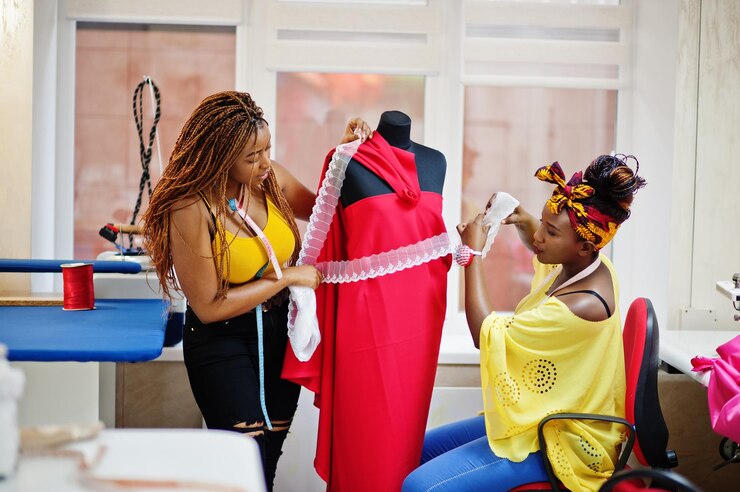
While the spotlight often shines on the glamorous aspects like runway shows and high-end designer collections, the journey from a creative concept to a finished product in a consumer’s wardrobe is intricate and multifaceted. This article delves deep into the business of fashion, detailing each stage from concept to production to market, shedding light on the processes that drive the industry forward.
1. Ideation and Concept Development
The journey of a fashion product begins with an idea. This stage is where creativity takes center stage, laying the foundation for everything that follows.
Inspiration and Research: Designers draw inspiration from various sources—cultural movements, historical references, art, travel, magazines and even current events. These inspirations are essential in defining the aesthetic and thematic direction of the collection. However, inspiration alone isn’t enough; designers must also conduct market research to understand current trends, consumer preferences and gaps in the market. This research helps in aligning the creative vision with what consumers are looking for.
Trend Forecasting: Fashion is a trend-driven industry. Designers rely on trend forecasting agencies, which analyze global cultural, economic, and social influences to predict upcoming trends. These forecasts provide insights into the colors, fabrics, silhouettes, and styles that will be in demand in the upcoming seasons, allowing designers to create collections that are both innovative and commercially viable.
Mood Boards and Conceptualization: Once the inspiration and trends are clear, designers create mood boards that encapsulate the essence of the collection. These boards serve as a visual reference, combining colors, textures, images, and materials that will inform the design process. From these, initial sketches are made, translating abstract ideas into tangible designs.
2. Design and Prototyping
After the conceptual groundwork is laid, the next step is turning ideas into physical designs. This stage is critical in determining how the concept will translate into actual garments.
Sketching and Technical Design: Designers start by creating detailed sketches of their ideas. These sketches include not only the look of the garments but also specific details like seams, stitches, and embellishments. Technical designers then create detailed technical drawings and specifications, which include measurements, fabric choices and construction methods. These technical specifications are crucial for the next stages of development and production.
Material Sourcing: Choosing the right fabrics and materials is vital in realizing a designer’s vision. Designers and material specialists work together to source fabrics that meet the design’s aesthetic and functional requirements. This process often involves collaborating with textile manufacturers, attending fabric trade shows, and considering factors like durability, cost, and sustainability. The choice of materials can significantly impact the final product’s quality, look, and feel.
Pattern Making and Sample Production: Patterns are created based on the technical designs. These patterns are essentially templates used to cut the fabric into the required shapes and sizes. Pattern makers must be precise, as any error can lead to a poor fit or wasted materials. Once the patterns are made, the first samples or prototypes are produced. These prototypes are usually handcrafted and undergo several rounds of fitting and refinement. Designers and pattern makers work closely to ensure that the garment fits well, looks good, and functions as intended.
Fittings and Adjustments: The initial samples are fitted on models or dress forms to assess the garment’s fit, drape, and overall appearance. This stage often involves multiple iterations, where designers tweak the design, adjust patterns, and refine the construction to perfect the garment. It’s a crucial step to ensure that the final product meets the designer’s standards before moving into mass production.
3. Production and Manufacturing
Once the design is finalized and approved, the focus shifts to production. This stage involves complex logistics and coordination to transform prototypes into mass-produced garments ready for the market.
Pre-Production Planning: Before production begins, detailed pre-production planning is essential. This includes finalizing the bill of materials (BOM), which lists all the components required for production, such as fabrics, trims, and accessories.
Manufacturing Process: The manufacturing process varies depending on the scale and type of fashion brand. Luxury and high-end fashion often involve intricate, labor-intensive processes, with many garments being handcrafted or produced in limited quantities. In contrast, fast fashion brands focus on speed and efficiency, using automated processes and large-scale production methods to quickly bring trendy, affordable items to market.
Cutting and Sewing: Once the fabric is delivered, it’s cut according to the patterns. The cut pieces are then sewn together, either by hand or with industrial sewing machines. Each garment passes through several stages, from assembling the basic structure to adding details like zippers, buttons, and embroidery.
Quality Control: Throughout the manufacturing process, quality control checks are conducted to ensure that each garment meets the brand’s standards. This includes inspecting the stitching, ensuring consistent sizing, and checking for defects or flaws in the fabric. High-quality brands often have multiple quality control checkpoints to maintain their reputation for excellence.
4. Marketing and Branding
With the products ready for market, the next phase focuses on building brand identity and generating consumer interest. Effective marketing and branding are crucial in positioning a fashion brand in a competitive market.
Brand Identity Development: A strong brand identity is vital in differentiating a fashion brand from its competitors. This identity is crafted through a combination of visual elements (logos, color schemes, packaging) and brand messaging that conveys the brand’s values, mission, and unique selling proposition. Whether a brand is known for luxury, sustainability, or affordability, a clear and consistent brand identity helps attract and retain customers.
Digital Marketing and Social Media: In today’s digital landscape, online marketing is essential for reaching and engaging consumers. Fashion brands leverage social media platforms like Instagram, TikTok, and Pinterest to showcase their collections, share behind-the-scenes content, and connect with their audience. Influencer marketing is also a powerful tool, where brands collaborate with influencers to promote their products to a broader audience. Additionally, email marketing, content marketing, and search engine optimization (SEO) are used to drive traffic to e-commerce sites and increase brand visibility.
Fashion Shows and Campaigns: Fashion shows, whether physical or virtual, remain a cornerstone of fashion marketing. These events generate excitement, set trends, and create a buzz around new collections. These campaigns are designed to tell a story, evoke emotions, and create a desire for the brand’s products.
Public Relations and Media Outreach: Fashion brands work with PR agencies to secure media coverage, manage brand reputation, and handle crisis communication. Press releases, interviews, and exclusive previews are used to generate media interest and enhance the brand’s public image. Media coverage can significantly boost a brand’s visibility and credibility, especially when featured in prestigious fashion magazines or by influential fashion journalists.
At Creative Money, we have resources, tools and strategies that help fashion brands reach a wider audience, access global markets and increase sales.
5. Distribution and Retail
After the marketing efforts have generated interest, the focus shifts to making the products accessible to consumers. This stage involves selecting the right distribution channels and ensuring a seamless shopping experience.
Retail Channels: Fashion brands use a variety of retail channels to reach consumers, including flagship stores, department stores, boutiques, online platforms and pop-up events. Each channel serves a different purpose—flagship stores offer a full brand experience, while department stores and boutiques increase accessibility to a broader audience. Brands must carefully manage their retail partnerships to maintain brand integrity and control over pricing and product presentation.
E-commerce and Digital Platforms: E-commerce has revolutionized the fashion industry, allowing brands to reach a global audience without the need for physical stores. Brands invest in user-friendly websites, mobile apps, and digital marketing strategies to drive online sales. Features like virtual try-ons, personalized recommendations, and easy return policies enhance the online shopping experience and encourage repeat purchases.
Omni-Channel Strategies: To provide a cohesive shopping experience, many brands adopt an Omni-channel approach, integrating online and offline channels. For example, consumers might browse products online, check availability at a nearby store, and choose to pick up their order in person. This seamless integration ensures that consumers can interact with the brand in multiple ways, enhancing convenience and satisfaction.
Inventory Management and Logistics: Efficient inventory management is crucial to meeting consumer demand and avoid overstock or stockouts. Brands use inventory management systems to track stock levels, predict demand, and manage distribution across various retail channels. Logistics partners play a key role in ensuring timely delivery of products to stores and customers, maintaining the brand’s reputation for reliability.
6. Consumer Engagement and Loyalty
The final stage in the fashion business process is building lasting relationships with consumers. This involves not only selling products but also creating a loyal customer base that will continue to support the brand. It is more effective to retain existing customers and turn them into repeat customers, who will not only consistently patronize you, but through positive word-of-mouth, connect you to other customers.
Customer Experience: Providing an exceptional customer experience is vital for building brand loyalty. This includes offering personalized shopping experiences, responsive customer service, and easy returns and exchanges. Brands that prioritize customer satisfaction often see higher retention rates and positive word-of-mouth referrals.
Loyalty Programs: Loyalty programs are used to reward repeat customers. These programs might offer points for purchases, exclusive discounts, early access to new collections, and personalized recommendations. Loyalty programs not only encourage repeat business but also help brands gather valuable data on customer preferences and behavior.
